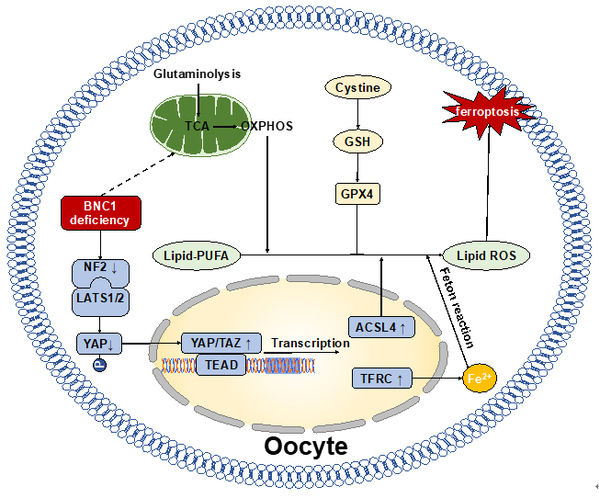Primary ovarian insufficiency (POI) is a clinical syndrome defined as premature exhaustion of the resting pool of primordial follicles before the age of 40 years and characterized by oligo-/amenorrhea for at least 4 months with elevated gonadotrophins. Approximately 1% of women under 40 years of age are affected. POI causes severe daily life disturbances in these patients, including hot flashes, sweating, sleep disorders, vaginal dryness, depression, and compromised mental health. Another major concern related to POI is the reproductive health impairment and even infertility among women of reproductive age.
On October 5, 2022, a research paper titled “BNC1 deficiency-triggered ferroptosis through the NF2-YAP pathway induces primary ovarian insufficiency” was published online in Nature Communications by the research group of Prof. ZHANG Dan from the Key Laboratory of Reproductive Genetics (Ministry of Education) and Department of Reproductive Endocrinology, Women's Hospital, Zhejiang University School of Medicine. The pathologic mechanism of POI based on oocyte ferroptosis was revealed, subverting the classical cognition.

The research group led by Prof. ZHANG Dan previously identified a Basonuclin 1 (BNC1) mutation from a large Chinese POI pedigree and found that mice with targeted Bnc1 mutation exhibited symptoms of POI (Human Molecular Genetics, 2018). However, the underlying mechanism remained unknown.
In this study, Prof. ZHANG Dan’ s research team focused on the underlying mechanism of BNC1 targeted mutation leading to POI, and found that BNC1 played key roles in ovarian reserve and maintaining lipid metabolism and redox homeostasis in oocytes during follicle development. Deficiency of BNC1 resulted in premature follicular activation and excessive follicular atresia. Mechanistically, BNC1 deficiency triggered oocyte ferroptosis via the NF2-YAP pathway. The research team demonstrated that pharmacologic inhibition of YAP signaling or ferroptosis significantly rescued Bnc1 mutation-induced POI. These findings uncovered a new pathologic mechanism of POI based on BNC1 deficiency, and suggested YAP and ferroptosis inhibitors as potential therapeutic targets for POI. Just as Prof. ZHANG Dan says, “this study clarifies the role and mechanism of BNC1-NF2-Hippo-YAP signaling -Ferroptosis axis in POI, and establishes a new potential treatment method for POI based on ferroptosis, which provides a new theoretical basis for the clinical precise prevention and treatment of primary ovarian insufficiency”.

Prof. ZHANG Dan (the fourth from the right on the front line) and her team
Source: Zhejiang University School of Medicine
(From ZJU NEWSROOM)

